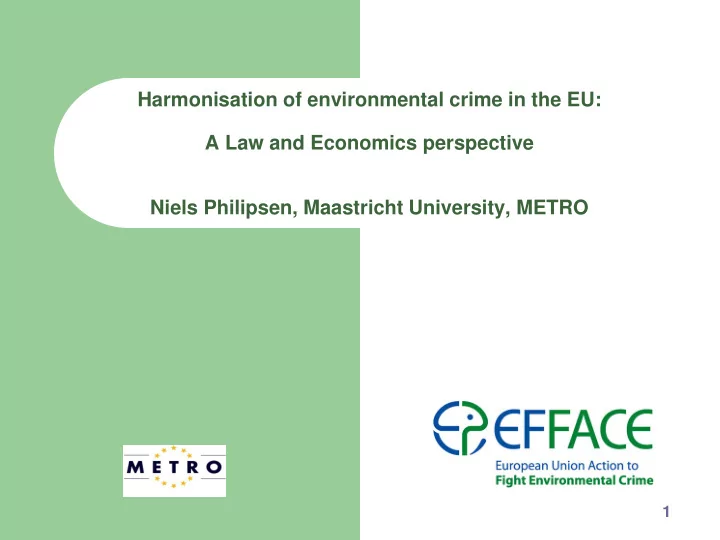

Harmonisation of environmental crime in the EU: A Law and Economics perspective Niels Philipsen, Maastricht University, METRO 1
Introduction Structure of presentation : – Economic theory of federalism Bottom-up approach Criteria for harmonisation Applied to environmental law Applied to criminal law – Role of enforcement – Conclusions and some additional remarks 2
Economics of federalism: bottom-up approach Starting from a local / national level close to the (preferences of) people – Tiebout’s theory of local public goods – example: culture vs sports “voice” and “exit” can also be applied to law (e.g. Van den Bergh, Frey, Revesz) – preferences for law differ: examples competition between jurisdictions (full harmonisation creates a monopoly) learning effect Harmonisation / federalisation can be efficient in case of specific problems 3
Economics of federalism: criteria for harmonisation Economic arguments transboundary externalities and economies of scale 1. race to the bottom 2. reduction of transaction costs 3. (creating a ‘level playing field’) 4. private interest explanations 5. Non-economic arguments creating a ‘level playing field’ – minimum protection of consumers – equal treatment and access to justice – 4
(1) Transboundary externalities Transboundary (negative) externalities many examples in environmental law – there is no argument for harmonisation if the cross-border element – is lacking Economies of scale of European legislation? Is it possible to solve these externalities bilaterally (‘Coasean bargaining’)? 5
(2) Preventing a race to the bottom Lenient legislation in order to attract business? prisoner’s dilemma argument – examples include corporate taxes, consumer protection, and also – environmental standards However: is there really a race to the bottom or perhaps a race to the top? Empirical evidence is important pollution / tax haven hypothesis New EU Member States and possible relation with the race to the bottom argument 6
(3) Reduction of transaction costs – lower transaction costs for market participants because one law rather than many transaction costs: costs of using the market (e.g. information, contracting, monitoring) – however: also take into account the costs of harmonisation Member States have to agree on the new (harmonised) law – note e.g. that many issues are not included in ELD and PLD! influence of private interest groups / lobbying? 7
(4) Creating a ‘level playing field’ Harmonization of marketing conditions? Why would we do that? => likely to lead to less functioning of markets and to ‘sameness’ (in Dutch: eenheidsworst ) In EU: internal market argument => but we have the four freedoms! the argument may however apply in relation to access to justice for companies and individuals in environmental matters 8
(5) Private interest explanations Corporate interests – lobbying at the regional, antional or European level: where do corporations have the largest influence? EU interests – European Commission – European Parliament Key question: does regulation serve the public interest? 9
Non-economic arguments Creating a ‘level playing field’ Minimum protection of consumers – why at European level? – often conflicting with economic arguments (efficiency) example: compensation of victims in Portugal is different from compensation in Germany Others, such as equal treatment and (related to the above) access to justice 10
Role of enforcement ‘ Economics of federalism’ theory has often been applied to substantive law, less to procedural law In reality the problem may not lie in the content of the substantive law, but in the way the law is enforced (including the procedures)! – this also applies to environmental law – criminalisation may not be the answer to the lacking enforcement of national law, including national criminal law 11
Conclusions and some additional remarks Applying economic theory to (substantive) environmental law, the first argument applies; maybe also the second and third – also: a level playing field in relation to access to justice? Environmental criminal law: there are good reasons to criminalize some offenses, but harmonization of penalties seems far-fetched – does criminalization solve the (enforcement) problem? There are alternatives to full harmonisation, which are relevant to EFFACE – Regulations vs. Directives, Recommendations, etc. 12
Recommend
More recommend